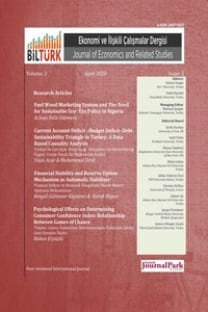Importance of Relational Database Approach to Achieve Circular Economy
circular economy, linear economy, relational database, stakeholder matching
Importance of Relational Database Approach to Achieve Circular Economy
___
- Alvarez, R., & Ruiz-Puente, C. (2017). Development of the Tool Symbiosys to Support the Transition Towards a Circular Economy Based on Industrial Symbiosis Strategies. Waste and Biomass Valorization, Vol. 8, No. 5, p. 1521-1530.
- Bauman, Z. (1999). In Search of Politics. Polity Press: Cambridge
- Bocock, R. (1997). Tüketim. (Çev., Grem Kutluk) Dost Kitabevi Yayınları, Ankara.
- Boulding, K. E. (1966). The Economics of the Coming Spaceship Earth. Environmental Quality Issues in a Growing Economy.
- Ceceljaa, F., Raafata, T., Trokanasa, N., Innesc, S., Yanga, A., Smithc, M., ... & Kokossisb, A. (2012). E-Symbiosis: A Technology-enabled Industrial Symbiosis Targeting SMEs and Innovation. In Proceedings of Conference on the Greening of Industry Network, 22–24 October. Sweden.
- Chertow, M. R., & Lombardi, D. R. (2005). Quantifying Economic and Environmental Benefits of Co-located firms. Esymbiosis- Development of Knowledge-based Web Services to Promote and Advance Industrial Symbiosis in Europe, http://esymbiosis.clmsuk.com/
- Fromm, E. (2004). Çağdaş Toplumların Geleceği. (çev. Aydın Arıtan-Kaan H. Ökten). İstanbul: Arıtan Yayınları.
- Frosch, R. A., & Gallopoulos, N. E. (1989). Strategies for Manufacturing. Scientific American, Vol. 261, No. 3, p. 144-153.
- Jacobsen, N. B. (2006). Industrial Symbiosis in Kalundborg, Denmark: A Quantitative Assessment of Economic and Environmental Aspects. Journal of Industrial Ecology, Vol. 10. No. 1‐2, p. 239-255.
- Jung, M. G., Youn, S. A., Bae, J., & Choi, Y. L. (2015, November). A study on Data Input and Output Performance Comparison of Mongodb and Postgresql in the Big Data Environment. In 2015 8th International Conference on Database Theory and Application (DTA) (p. 14-17). IEEE.
- Krausmann, F., Gingrich, S., Eisenmenger, N., Erb, K. H., Haberl, H., & Fischer-Kowalski, M. (2009). Growth in Global Materials Use, GDP and Population During the 20th Century. Ecological Economics, Vol. 68, No. 10, p. 2696-2705.
- Li, M., Du, X. Y., & Wang, S. (2005, August). Learning Ontology from Relational Database. In 2005 International Conference on Machine Learning and Cybernetics, Vol. 6, p. 3410-3415). IEEE.
- McNeill, J. R. (2001). Something New under the Sun: An Environmental History of the Twentieth-Century World (the global century series). WW Norton & Company.
- Meadows, D.H., Meadows, D.L. & Randers, J. (1992). Beyond the Limits: Global Collapse or a Sustainable Future. Earthscan Publications, London.
- Meadows, D.H., Meadows, D.L. & Randers J. (1972). Beyond the Limits, Wite River Junction. VT: Chelsea Green Publishing Company.
- Murray, A., Skene, K., & Haynes, K. (2017). The Circular Economy: An Interdisciplinary Exploration of the Concept and Application in a Global Context. Journal of Business Ethics, Vol. 140, No. 3, p. 369-380.
- Prieto-Sandoval, V., Jaca, C., & Ormazabal, M. (2017). Circular economy: Relationship with the Evolution of the Concept of Sustainability and Strategies for its Implementation. Memoria-Investigaciones En Ingenieria, Vol. 15, p. 85-95.
- Reike, D., Vermeulen, W. J., & Witjes, S. (2017). The Circular Economy: New or Refurbished as CE 3.0?- Exploring Controversies in The Conceptualization of the Circular Economy through a Focus on History and Resource Value Retention Options. Resources, Conservation and Recycling.
- Schaffartzik, A., Mayer, A., Gingrich, S., Eisenmenger, N., Loy, C., & Krausmann, F. (2014). The Global Metabolic Transition: Regional Patterns and Trends of Global Material Flows, 1950–2010. Global Environmental Change, Vol. 26, p. 87-97.
- Su, B., Heshmati, A., Geng, Y., & Yu, X. (2013). A Review of the Circular Economy in China: Moving from Rhetoric to İmplementation. Journal of Cleaner Production, Vol. 42, p. 215-227.
- Tibbs, H. (1996). Sustainability: The Source Of The Crisis. Global Business Network: Scenario Thinking.
- Urbinati, A., Chiaroni, D., & Chiesa, V. (2017). Towards a New Taxonomy of Circular Economy Business Models. Journal of Cleaner Production, Vol. 168, p. 487-498.
- Van Berkel, R. (2007). Eco-efficiency in Primary Metals Production: Context, Perspectives and Methods. Resources, Conservation and Recycling, Vol. 51, No. 3, p. 511-540.
- Vasiljevic-Shikaleska, A., Gjozinska, B., & Stojanovikj, M. (2017). The Circular Economy-A Pathway To Sustainable Future. Journal of Sustainable Development, Vol. 7, No. 17, p. 13.
- Walsh, B. (2007). The Gore interview. Time, Vol. 170, No. 27, p. 98.
- Wilts, H. (2016). Germany on the Road to a Circular Economy?. Friedrich-Ebert-Stiftung, Division for Economic and Social Policy.
- Yazan, D. M., & Fraccascia, L. (2020). Sustainable Operations of Industrial Symbiosis: An Enterprise Input-Output Model Integrated by Agent-Based Simulation. International Journal of Production Research, Vol. 58, No. 2, p. 392-414.
- Yifang, L., Renchen, T., & Jian, X. (2007). The Input-Output Analysis of The Circular Economy. In 16th International Input-output Conference.
- Worldwatch Institute-Dünyanın Durumu (2004). Sürdürülebilir Toplum İçin Worldwatch Enstitüsü Raporu, Türkiye İş Bankası Kültür Yayınları, TEMA Vakfı Yayınları, İstanbul.
- Yayın Aralığı: Yılda 4 Sayı
- Başlangıç: 2019
- Yayıncı: Fatih DEYNELİ
Social Capital and Loan Repayment Capacity of Agripreneurial Groups' in Abia State, Nigeria
Chidinma Rosemary OKEZIE, Ifeanyı Moses KANU, Cynthia Chisom IWU
Nurul HİDAYAH, Lucky NUGROHO, Hendi PRİHANTO
Importance of Relational Database Approach to Achieve Circular Economy
Social Capital and Loan Repayment Capacity of Agripreneurial Groups' in Abia State, Nigeria
Chidinma Rosemary OKEZIE, Ifeanyı Moses KANU, Cynthia Chisom IWU
